|
< Earlier Kibitzing · PAGE 1 OF 2 ·
Later Kibitzing> |
| Feb-01-08 | | Sergius64: Looks like the continuation would be:
27 ...Kf5 28. Qe6+ Kg5 29. Qxe5+ Kh6 30 Qxc3
If black tried 28. ...Ke4 instead of ...Kg5 he would lose even more badly with 29. Qg4+ Kd3 30. Qxa4 |
|
| Feb-01-08 | | Aspirador: <sergius> In your line 27 ...Kf5 28. Qe6+ Kg5 29. Qxe5+ Kh6 the move 30.Bf8# looks better than 30.Qxc3?? Qd1# Goes from thumbs up to thumbs down. |
|
| Feb-05-08 | | hedgeh0g: Qd1 isn't checkmate. Don't forget about 31. Qe1 :P |
|
| Nov-02-16 | | dzechiel: <Sergius64> In your line after 29...Kh6 I think 30 Bf8# is the better continuation. |
|
| Nov-02-16 | | slasher14: What is the continuation after 26...Kg8? White's B is en prise, he has a mate threat to deal with, and as long as Black's K stays on the white squares, how does White finish him off? |
|
| Nov-02-16 | | dzechiel: Anticipated by <Aspirador>. I should have read the next comment! |
|
| Nov-02-16 | | slasher14: Ooop. Saw it. 27 Qa8 Kf7 28 Qf8# |
|
| Nov-02-16 | | Fish55: Doesn't 26.Qe6+, Kg7 27.Qxe5+, Kg8 28.Qb8+ force mate? |
|
| Nov-02-16 | | patzer2: Knowing it's a puzzle, I found 25. Rxf7+ to be an easy first move solution to today's Wednesday puzzle. After 25. Rxf7+ Kxf7, I deviated from the game continuation with 26. Qe6+ which the computer (i.e. Deep Fritz 15) indicates forces mate-in-six. After 26. Qe6+ Kg7 27. Qxe5+ Kg8 28. Qb8+, White forces mate-in-four after 28...Kf7 (28...Kg7 29. Qf8#) 29. Qf8#. Futile interposition with the Black Rook and Queen drags it out to mate-in-six. For a Black improvement, instead of 12...Bd7? 13. Qxb7  dropping a pawn, I prefer 12...Rb8 = (0.18 @ 20 depth, Deep Fritz 15). dropping a pawn, I prefer 12...Rb8 = (0.18 @ 20 depth, Deep Fritz 15). Earlier, instead of 11...Nxf3 12. Qxf3 =, I like 11...a6 = (0.10 @ 20 depth, Deep Fritz 15) because it keeps more tension in the position while giving Black full equality and active counter play. |
|
| Nov-02-16 | | lost in space: My way was 25. Rxf7+ Kxf7 26. Qe6+ and I think mate somewhere soon. |
|
| Nov-02-16 | | AlicesKnight: I also went for 25.Rxf7+ Kxf7; 26.Qe6+ Kg7; and then 27.Qe7+ Kh6 (...Kh/g8 leads to Qf8#); 28.Qf8+ but it doesn't look conclusive as the Black Q gets to intervene later; Ivanchuk is right. |
|
| Nov-02-16 | | leRevenant: I also went for 25.Rxf7+ Kxf7; 26.Qe6+ |
|
| Nov-02-16 | | Cheapo by the Dozen: I didn't analyze accurately all the way to mate. But I would have played the game line anyway, since it was the only way I could see that White wouldn't get a material disadvantage or worse. |
|
| Nov-02-16 | | mel gibson: Saw it in 3 seconds.
DR4 64 bit says
25 Rxf8+
score = mate in 11 |
|
| Nov-02-16 | | BjarneNielsen: <dzechiel> how nice to see you back. I, for one, have missed you! |
|
| Nov-02-16 | | gofer: We are a whole bishop up, but we have significant back rank weaknesses. So we could just give back
the bishop by playing <25 h3>. But that seems a little tame, whereas we could give up the rook and
keep the bishop and go for broke... ...but does it work?! <25 Rxf7+ ...>
Black cannot run...
25 ... Kh8
26 Qf6 Kg8
27 Qg7#
25 ... Kh6
26 Bf8+ Kh5 (Kg5 27 Qf6+ mating in two)
27 Rxh7+ Kg5 (Kg4 28 Qxg6#)
28 h4+ Kf5
29 Qe6+ Ke4
30 Qg4+  (winning the queen) (winning the queen)
Black cannot accept...
25 ... Kxf7
26 Qxa7+ Kf6 (Ke8 27 Qe7# or Kg8 27 Qa8+ Kf7/Kg7 28 Qf8#)
27 Qe7+ Kf5
28 Qe6+ Kg5 (Ke4 Qg4+ winning the queen)
From here the win is forced...
29 f4+! exf4
30 h4+! Kh6
31 Bf8+ Kh5
32 Qe5+ Kxh4
33 Be7+ Kg3
34 Qg5#
So the only question is can black hide ? <Behind the rook!!!> <25 ... Kg8>

click for larger viewNow this makes things more tricky!!! We can't allow Qd1+ as that stops
our nice plan of Qg4+ at some point winning Qa4, so do we have to play the following?!?! <26 Rf8+ Kg7>
<27 Qf6+ Kh6>
<28 h3 ...>

click for larger viewI can't see anything better... ...so we lose the bishop
but have a winning attack on the poor black king! |
|
| Nov-02-16 | | gofer: <BjarneNielsen: <dzechiel> how nice to see you back. I, for one, have missed you!> Agreed! Welcome Back! |
|
| Nov-02-16 | | patzer2: From the final position of the game, White wins after 27...Kf5 [] 28. Qe6+ Ke4 [28... Kg5 29. Qxe5+ Kg4 (29...Kh6 30. Bf8#) 30. h3+ Kh4 31. Be7+ g5 32. Qxg5#] 29. Qg4+ Kd3 30. Qxa4 (diagram below):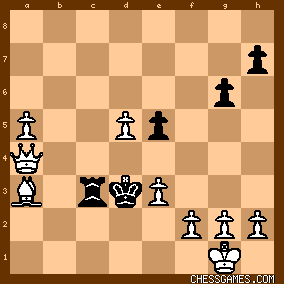
click for larger viewWith White a Queen up, the computer (Deep Fritz 15) indicates it's mate-in-eight for the first player. P.S.: The 26. Qe7+ continuation is more difficult (or at least longer) than the 26. Qe6+ line, but visualizing it is apparently no problem for a Super GM like Ivanchuk. |
|
| Nov-02-16 | | agb2002: White is a bishop and pawn ahead.
Black threatens Q(R)xa3.
White can start an attack against the black king with 25.Rxf7+: A) 25... Kxf7 26.Qe6+ Kg7 27.Qxe5+
A.1) 27... Kf7 28.Qe7+ Kg8 29.Qf8#.
A.2) 27... Kg8 28.Qb8+ (28.Qxc3 Qd1+ 29.Qe1 Qxe1#) and mate in three. A.3) 27... Kh6 28.Bf8#.
B) 25... Kg8 26.Rf8+ Kg7 27.Rg8+
B.1) 27... Kxg8 28.Qe6+ Kg7 (28... Kh8 29.Qf6+ Kg8 30.Qf8#) 29.Qxe5+ transposes to A. B.2) 27... Kf7 28.Qe6#.
B.3) 27... Kh6 28.Bf8+
B.3.a) 28... Kg5 29.h4+ eliminates the mate threat and keeps both the attack and material advantage. B.3.b) 28... Kh5 29.Qe2+ Qg4 (29... Kh4 30.Be7+ g5 31.Bxg5#; 29... Kg5 30.h4+ as above) 30.Qxg4+ Kxg4 31.h3+ + - [B+2P]. C) 25... Kh8 26.Qf6+ Kg8 27.Qg7#.
D) 25... Kh6 26.Bf8+
D.1) 26... Kg5 27.Qf6+
D.1.a) 27... Kg4 28.h3+ Kh5 29.Rxh7#.
D.1.b) 27... Kh5 28.Rxh7+ Kg4 29.Rh4# (or 29.h3#, 29.f3#). D.2) 26... Kh5 27.Qe2+ (27.Rxh7+ Kg5 28.Be7+ Kf5 (28... Kg4 29.Qe6#) 29.Qe6+ Ke4 30.Rh4+ Kd3 31.Rxa4 Rc1#) D.2.a) 27... Kg5 28.f4+ exf4 (28... Kh4 29.Rxh7#) 29.exf4+ wins. D.2.b) 27... Kh4 28.Be7+ g5 29.Rxh7#.
D.2.c) 27... Qg4 28.Rxh7+ Kg5 29.Be7+ Kf5 30.e4+ Kf4 (30... Qxe4 31.Rf7#) 31.Rf7+ Qf5 32.g3+ Rxg3+ 33.f(h)xg3#. |
|
| Nov-02-16 | | DIO: +3 <dzechiel>! Hopefully this is a sign for more frequent posts? :-) |
|
Nov-02-16
 | | Sally Simpson: The first post in this thread is one of the best jokes I've seen. After the lad's analysis he gets to here and suggests; 
click for larger view30.Qxc3.
Not only missing mate in one for White but after 30.Qxc3 Qd1+ it's White who gets mated. |
|
Nov-02-16
 | | Jimfromprovidence: I got 25 Rxf7+ Kg8 26 h3.
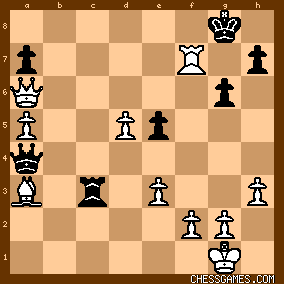
click for larger view If 26...Kxf7, then 27 Qe6+ leads to mate.
If either 26...Qxa3 or 26...Rxa3, then 27 Qf6 leads to mate. If 26...Qd1+ 27 Kh2 Qxd5, then 27 Rf8+, below, leads to mate. 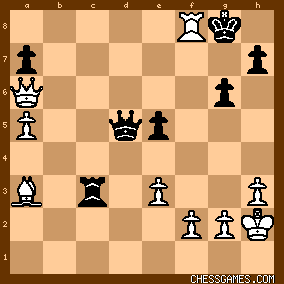
click for larger view |
|
| Nov-02-16 | | YouRang: Wednesday 25.?

click for larger view
Both sides have threats (and black's look more threatening), but white gets to move first. Given black's threats, I figured white would be looking for a move that (1) gives check, and (2) exposes black's king to further checks, and mate. This thinking makes <25.Rxf7+!> the obvious try, and it's not too hard to see that the rook is immune: <25...Kxf7? 26.Qe6+ Kg7 (forced) 27.Qxe5+ Kg8> (...Kh6? Bf8#; ...Kf7? Qe7+ & Qf8#) <28.Qb8+> (soon followed by ...Kg7 Qf8#). However, the king can't successfully run away either: - 25...Kh6 27. Bf8+ and the queen will join the attack with check via f6 or e2. - 25...Kg8 27.Rf8+ Kg7 28.Qf6+ Kh6
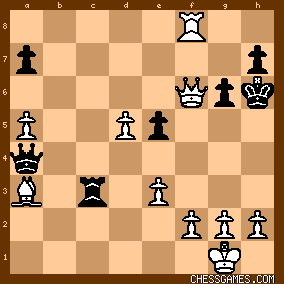
click for larger view
Now 29.h4! adds to white's attack while also defusing black's back-rank threat, leading to Qg5+, Qxe5+, Rg8 (threat Qg5#). |
|
| Nov-02-16 | | residencial master: I saw the better line mate in 4, after kxf7, Qg6+ and then kg7 - Qxe5+ = kg8 with Qb8+ the 2 square that the king have to go is mate Kf7 - Qf8#, Kg7 - Qf8# |
|
| Nov-02-16 | | YouRang: Ivanchuk's line with <26.Qxa7+> (rather than 26.Qe6+) is interesting, as the Qf8# threat looms immediately unless black plays <26...Kf6>. But in that case, the king is totally flushed out after <27.Qe7+>. The only little complication is that the king can run to e4: <27...Kf5 26.Qe6+ Ke4>
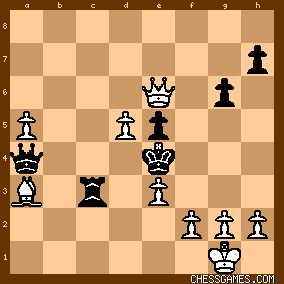
click for larger view
At this point, white has only one way to win: <29.Qg4+!> winning the Q with a skewer -- and mate won't be far behind. |
|
 |
|
< Earlier Kibitzing · PAGE 1 OF 2 ·
Later Kibitzing> |





